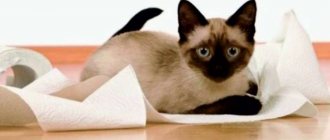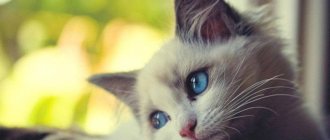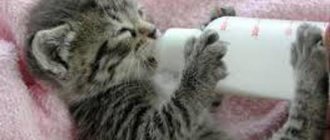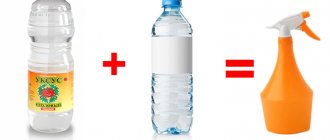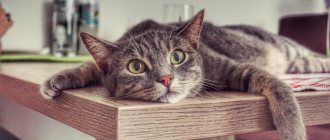| Article verified by a practicing veterinarian |
Have you ever come home and found vandalism committed against defenseless indoor plants? Have you ever woken up at night from a loud bang and the realization of an impending unplanned night cleaning? Spending on flower pots, soil, new exhibits in the home greenhouse, resentment and disappointment - is this all familiar? If you are looking for an answer to the question of how to wean a cat from eating indoor plants, then in this article you will get the most detailed answer with options for solving the problem.
Poisonous plants for cats
If a cat eats flowers, how to stop it from doing so? And is it necessary?
The fact is that some plants, or rather the substances in them, are poisonous to cats. In case of mild poisoning, the owner will have to deal with allergic reactions, rinsing the mouth, and nausea in the animal. In case of acute poisoning, urgent hospitalization of the animal and a fight for its life may be necessary.
For example, one of the most dangerous flowers are lilies of the genus Lilium Hemerocallis . The substances they contain are toxic and can cause severe kidney failure and even death.
If lilies appear in the house, keep them out of the cat's reach to save his life
Any part of a flower is dangerous, and even just a few petals can have serious health effects.
Symptoms of poisoning include severe drooling, vomiting, a sharp decrease or increase in the amount of urine, and dehydration.
Mistletoe and daffodils cause convulsions, gastrointestinal irritation, collapse, and lower blood pressure.
Autumn colchicum is one of the most dangerous plants. Causes shock, damage to internal organs, vomiting blood, suppression of bone marrow.
Poinsettias cause itching and pain in the mouth area.
There are more than 400 species of plants that are dangerous to cats. Of these, in the house or country house you can most often find:
- Azalea. Contains andromedotoxin. May cause vomiting, diarrhea, weakness, convulsions, changes in heart rhythm. In extreme cases, death.
- Alocasia. Contains insoluble calcium oxalate crystals. Poisoning is accompanied by excessive salivation, difficulty swallowing, and swelling in the mouth. In very rare cases, breathing difficulties may occur.
- Aloe. Contains saponins. Poisoning from this common plant causes diarrhea, nausea, loss of appetite, tremors and discoloration of urine.
- Belladonna\Amarilis. Your cat may come across this plant if he lives in the country. Eating flowers can cause tremors, severe abdominal pain, vomiting, diarrhea, and refusal to eat.
- Anthurium. Contains calcium oxalate crystals. They cause swelling and pain in the mouth.
- Begonia. Contains soluble calcium oxalate crystals. Eating causes excessive salivation, irritation of the oral mucosa, vomiting, burns of the oral mucosa, and swelling of the larynx. Due to swelling of the larynx, an attack of suffocation and death can occur. Gardenia. Contains genioposide. Causes gastrointestinal disorders. In case of poisoning, diarrhea and vomiting are observed.
- Geranium. Contains geraniol and linalool. May cause vomiting, diarrhea, anorexia (refusal to eat) and dermatitis.
- Hyacinth. Contains allergenic lactones, lycorine and calcium oxalate crystals. Most of the toxin is found in the bulbs. Causes dermatitis and gastrointestinal upset.
- Hydrangea. Contains cyanogenic glycosides. Causes gastrointestinal upset. The main symptoms of poisoning are vomiting and diarrhea.
- Dieffenbachia. Contains calcium oxalate crystals. Poisoning is accompanied by irritation of the oral cavity, itching, burning, excessive salivation, vomiting, decreased appetite, and difficulty swallowing.
- Dracaena. Contains saponins. In case of poisoning, dilated pupils, vomiting (with or without blood), loss of appetite, and weakness are observed.
- Calla lilies. Contains insoluble calcium oxalate crystals. The most dangerous are the bulbs. After eating, swelling and irritation in the oral cavity, excessive salivation, and vomiting occur.
- Kalanchoe. Contains glycosides and bufadienolides. Rarely causes arrhythmia. Most often, problems arise from the gastrointestinal tract. Symptoms include diarrhea, vomiting, irritation of the oral mucosa, and increased heart rate.
- Oleander. Contains cardiac glycosides. In case of poisoning, the functioning of the heart is disrupted. Symptoms include arrhythmia, changes in blood pressure, as well as gastrointestinal upset and dehydration.
- Ivy. Contains triterpene saponins. The most dangerous are the leaves. Departure is accompanied by abdominal pain and diarrhea, as well as drooling.
- Ficus. Contains ficin and ficusin. Causes disturbances in the gastrointestinal tract and skin irritation. Symptoms include rash, redness of the skin, as well as vomiting and diarrhea.
- Philodendron. Contains insoluble calcium oxalate crystals. Causes swelling in the mouth, difficulty swallowing and vomiting.
- Cyclamen. Contains cyclamine. Eating leaves and flowers causes drooling, diarrhea and vomiting. Roots are more dangerous. They can cause seizures and arrhythmia, even death.
- Euphorbia. Contains euphorbin. Provokes irritation of the gastric and oral mucosa and vomiting.
Methods
Cats cannot be trained, they are difficult to force or persuade, and physical punishment will provoke aggression towards the owner. To prevent your pet from touching indoor vegetation, you need to choose the right tactics or combine several methods at the same time.
Method 1. Scare away with smell and taste
With the help of aromas, animals navigate in space and determine healthy and unhealthy foods. The physiological characteristics of cats make it possible to wean cats from eating flowers.
There are three groups of odors:
- Citrus. The strong aroma of lemon, orange or tangerines is unpleasant for cats. Peels and fresh fruits are laid out around the pot. The greens are sprayed with decoctions of pulp and skins.
- Essential oils. Lavender, mint and eucalyptus cause severe rejection in animals. Add 10 drops of drugs to 250 ml of water, and treat problem plants with a spray bottle.
- Spices, spices. The smell of pepper and mustard, garlic and curry is detected by the cat's nose as poison. Solutions with seasonings are used to moisten foliage, trunks and flowerpots.
Aromatic substances quickly disappear, so you will have to spray the plants 4-5 times a day. A Levomycetin tablet dissolved in a glass of water will help enhance the properties of the odorous liquid. The concentration of antibiotic is not enough to cause poisoning, but the bitterness is enough to give you courage.
Reasons why cats destroy house plants
On the street, cats are interested in movements in the grass, because small rodents and large insects can hide there. And even though there are no pests in the house, the cat will be curious about any movement from the flower pot. Even a small draft is enough. Such interest can lead to the cat simply turning over the flower pot and breaking it.
Even if they are domesticated, cats are predators . Their diet consists of animal products. They use grass to cleanse the body of undigested food residues and replenish the body with macro and microelements.
Regardless of whether your cat is outdoors or not, he may begin to show a gastronomic interest in houseplants. Just because they smell delicious, for example.
To solve the question of how to wean a cat from eating flowers, you need to understand the catalysts.
The reasons why cats chew plants can be divided into psychological and physiological.
Psychological ones include:
- Curiosity. Cats are very curious creatures. You've probably noticed that they crawl into literally every crevice and every corner. They sniff everything carefully, and if they like the smell, they can taste it.
- Boredom. The life of a modern person rarely allows for a lot of time to communicate with loved ones, including animals. And if the cat doesn’t go out for a walk, he simply has nowhere to put his accumulated energy.
- Natural harmfulness. Animals, like people, have character traits. Unfortunately, they can also be harmful by nature.
- Revenge. Perhaps an unpleasant situation for the animal occurred earlier, which it associates with the plant.
- Perverted appetite is a symptom of gastrointestinal pathology. In this case, it is worth scheduling a visit to a veterinarian.
Physiological reasons include:
- Stomach cleansing. Blades of grass eaten by a cat irritate the gastric mucosa, thereby causing a gag reflex and emptying of the stomach contents. This happens to remove undigested food components, hairballs, and other foreign objects from the stomach.
- Lack of fiber. In nature, cats obtain fiber from their prey. If there is a lack of it, the animal may encroach on the owner’s favorite plant.
- Lack of iron or other nutrients.
Psychological methods to help protect flowers from being eaten
You can try to explain to the cat that you can’t touch the flowers growing in the house. If they don’t understand, then you can use pet scaring:
- For these purposes, you need to buy a water pistol and, as soon as you notice that the cat is heading towards the flowers, you need to spray a small stream of water at it. Gradually, the image that flowers are wet and cold will enter her consciousness, and she will forget the way to them. This procedure should only be carried out when cat grass is planted. Moreover, scaring is used only from those flowers that do not grow for animals to eat. This technique requires a lot of time, dexterity and observation of the owner.
- In the process of raising a kitten, you need to be firm and not give any slack to these cute creatures. As soon as he starts moving towards plants, you need to scold him. Moreover, this must be done constantly; eventually, the pet will understand its unwanted behavior.
- You can use store-bought cat bleach. It is placed in close proximity to flowers and reacts to the slightest movement of the animal. As soon as the cat is near the indoor plant, it begins its action. Depending on the type of action, they can emit an odor that is unpleasant to the pet, a water jet, a loud sound, such as a siren, or ultrasonic waves. This method is quite effective in preventing your pet from eating flowers.
The cat eats flowers. How to wean it - advice from veterinarians and isopsychologists.
Option 1
You can use a spray bottle with water . But there is a possibility that after this the animal will begin to be afraid of water procedures. Therefore, this method is not suitable for everyone. A better option is an air spray bottle , this is sold in many pet stores. As an option, you can simply blow on the cat: he is unlikely to like this.
Option 2
Grow your animal a mini-garden in his eating area. In the store you can buy seeds of oats, barley, lawn grass, and catnip. To germinate them you will need a container, soil, a dark place and a little care. When the sprouts begin to sprout, the plantation can be moved to a sunny window and allowed to grow for several days. Then place it near a bowl of food.
Every time you notice that the cat wants to spoil the plant, move the offender to the place where he eats. The point of this action is for the cat to get a cause-and-effect relationship in his head: food is always in one place, you can’t eat in other places.
If purchasing and growing seeds is problematic, the pet store sells ready-made boxes with sprouted grains.
Vitamin deficiency
Animals with free access to the outdoors can easily replenish the balance of essential nutrients with the help of various herbs. The pet's diet is mainly limited to dry food. The bad habit of encroaching on indoor flowers manifests itself in the autumn-spring period, when the lack of important vitamins and microelements is especially acute. Cats may eat green plants in hopes of getting missing nutrients.
Option 5
You can come up with decorative interior solutions . For example, on the inside of the windows, build a partition for pots with plants around the entire perimeter, which you can open and close.
It is not advisable to make hanging structures and shelves on the window itself, since cats love to climb into hard-to-reach places and show talent for climbing on absolutely flat surfaces. Such a decision may be perceived as a call to action.
But hanging pots are a good solution. The main thing is that they cannot be reached while jumping.
Hanging pots save you from cats
Cats don't like things rustling under their paws or fur sticking to them. Perhaps laying out foil or double-sided tape around the plant will help you. When using foil or tape, you must always remember that the animal can eat these items, which can end very badly.
Do no harm
Very often, a domestic predator simply simply does not have enough greenery. You need to buy a special mixture for planting grass, which sprouts very quickly. All cats eat such green shoots with pleasure. The pot with this special herb should be placed in the place where the most gnawed flower stands. When the cat becomes a little cooler towards flowers, it is better to move her grass away from valuable plants. Over time, the predator will have a path only to his personal lawn. But you need to keep an eye on this cat grass to make sure it is always available. Otherwise, attacks on flowers will resume again.
Special grass for cats
Swearing loudly with a cat or poking your nose at damaged flowers is very ineffective. It is only for the housewife that these plants on the window are valuable. For a cat, flowers are divided only into those that are convenient for nibbling or those that are inconvenient.
But how can you stop a cat from gnawing flowers if the cat’s grass is not to his taste? Then the process may be delayed. Some resources advise spraying the leaves with solutions with unpleasant odors for clawed predators. For example, citrus fruits. But this will not help much, sometimes it will even harm the plants more than a toothy cat.
My own experience has confirmed this. I sprayed a weak solution of citrus oil on the money tree that the kittens were dealing with. As a result, after 3 days, the tearing of leaves continued. And a week later, the money tree dropped almost all its leaves. The use of aerosols can lead to the complete death of the plant.
Gimpet Katzen Grass Fast-germinating grass for cats, 100 g
Price: 131 rub. 177 rub. 26% discount for you!
Cleanses the gastrointestinal tract and prevents constipation. Fast delivery throughout Russia. And also more than 3,000 other pet products at competitive prices! Take a look!
Option 6
Create a cat land. Make a lot of secluded places, lay out boxes and containers. Cats love to hide and get into tight places. Let him direct his cognitive energy to learning new things in the house.
Whatever you choose as a measure to combat indoor pests, remember that scolding, screaming and physically punishing are not about cats. If nothing helps at all, then you need to completely isolate the plants . Take it to another room, which will be locked. Or give them to friends, because the cat’s health is always more important.
Cat psychology to help
Some owners even talk to their cats about house flowers, but, as a rule, words are in vain. Action is needed, and the sooner the better.
- All cats hate water . Buy a water gun and use it as a pet repeller. As soon as the naughty guy takes a decisive step towards the flower pot, feel free to pull the trigger. Cold, wet streams will wash over the cat, and he will soon understand that eating house flowers is chilly and unpleasant. The cat will also remember the places in the apartment where he was sprayed and will try to avoid them.
- If the owner smiles tenderly at the kitten instead of raising his voice and scolding him on the matter, the pet will quickly become a spoiled child. He will understand that for eating flowers the owner himself “blossomed” in front of the prankster. This means that you need to please a person more often with your color mania.
- Can be bought in the store. The device must be placed close to the flowers. As soon as a playful cat steps towards a flower, the device will make a loud sound or splash water on the animal. There are devices that emit a smell that cats hate. This effective method has helped many owners.
